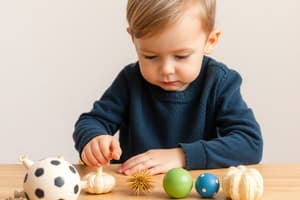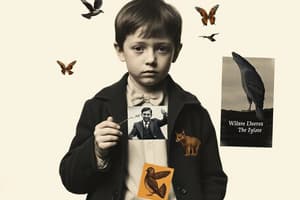Podcast
Questions and Answers
At what age do children typically start to demonstrate an understanding of living things?
At what age do children typically start to demonstrate an understanding of living things?
- 11-12 years
- 5-6 years
- 7-8 years (correct)
- 9-10 years
What is an example of personification that children might demonstrate around age 2?
What is an example of personification that children might demonstrate around age 2?
- Imagining a dog can cook
- Thinking the cup meant to fall (correct)
- Believing a tree can talk
- Assuming their toy can think
Which characteristic of living things is NOT typically understood by young children?
Which characteristic of living things is NOT typically understood by young children?
- They can get sick and recover
- They can talk and express emotions (correct)
- They can move on their own accord
- They grow
What concept indicates that living things have an 'essence' they inherit from their parents?
What concept indicates that living things have an 'essence' they inherit from their parents?
Why might preschoolers not enjoy magic shows?
Why might preschoolers not enjoy magic shows?
At what age do infants typically start pointing to inform others about events they do not know?
At what age do infants typically start pointing to inform others about events they do not know?
What does the first tier of the emotional-perception model suggest leads to actions and reactions?
What does the first tier of the emotional-perception model suggest leads to actions and reactions?
What do babies as young as 8 months old show a preference for in the circle, square, triangle experiment?
What do babies as young as 8 months old show a preference for in the circle, square, triangle experiment?
Which age group typically struggles with first-order theory of mind tasks?
Which age group typically struggles with first-order theory of mind tasks?
Core knowledge theorists believe there is a specific part of the brain responsible for which of the following?
Core knowledge theorists believe there is a specific part of the brain responsible for which of the following?
In terms of developing theory of mind, which birth order tends to perform better?
In terms of developing theory of mind, which birth order tends to perform better?
Which cultural group is noted for acquiring executive functions faster, according to the content?
Which cultural group is noted for acquiring executive functions faster, according to the content?
In the Jason and Lisa example, what is being tested?
In the Jason and Lisa example, what is being tested?
What allows us to learn from experience through categorization?
What allows us to learn from experience through categorization?
At what age do children begin to understand that they have different thoughts and beliefs from others?
At what age do children begin to understand that they have different thoughts and beliefs from others?
Which type of category do children typically learn first?
Which type of category do children typically learn first?
What is the significance of understanding why things have certain features in categorization?
What is the significance of understanding why things have certain features in categorization?
When do children typically start to imitate intended actions?
When do children typically start to imitate intended actions?
What does the term 'naïve psychology' refer to in child development?
What does the term 'naïve psychology' refer to in child development?
What is a common misconception about categorization in children?
What is a common misconception about categorization in children?
What concept relates to a child's understanding that desires can predict actions different from their own?
What concept relates to a child's understanding that desires can predict actions different from their own?
Which factor is not essential for categorization according to core knowledge theorists?
Which factor is not essential for categorization according to core knowledge theorists?
How do children typically categorize vehicles at a young age?
How do children typically categorize vehicles at a young age?
What is a significant developmental milestone related to spatial understanding that babies achieve before crawling?
What is a significant developmental milestone related to spatial understanding that babies achieve before crawling?
Which of the following best explains the concept of centration in young children’s understanding of time?
Which of the following best explains the concept of centration in young children’s understanding of time?
At what age do children start to understand the five principles of counting?
At what age do children start to understand the five principles of counting?
What ability do infants demonstrate through experiments with the bear on stage?
What ability do infants demonstrate through experiments with the bear on stage?
Which statement accurately reflects children's understanding of time intervals?
Which statement accurately reflects children's understanding of time intervals?
What are the two systems in animals and human infants related to numerical understanding?
What are the two systems in animals and human infants related to numerical understanding?
How do cultural tools influence children's understanding of space?
How do cultural tools influence children's understanding of space?
Which of the following describes the developmental difficulty children experience with ordering events?
Which of the following describes the developmental difficulty children experience with ordering events?
What does cardinality refer to in counting?
What does cardinality refer to in counting?
How does order irrelevance affect counting?
How does order irrelevance affect counting?
What is the primary reason Chinese children can count more numbers at a young age compared to American children?
What is the primary reason Chinese children can count more numbers at a young age compared to American children?
What does habituation refer to generally in infants?
What does habituation refer to generally in infants?
What is the main aim of violation of expectation experiments?
What is the main aim of violation of expectation experiments?
What can infants perceive in terms of intermodal perception?
What can infants perceive in terms of intermodal perception?
What do preferential looking experiments primarily measure in babies?
What do preferential looking experiments primarily measure in babies?
In the intermodal perception experiment with leg movements, what was monitored?
In the intermodal perception experiment with leg movements, what was monitored?
Flashcards are hidden until you start studying
Study Notes
Categorization
- Basic categories kids sort the world into: Inanimate objects, people, living things
- Children form their own basic categories based on shared characteristics – for example grouping all vehicles together due to the presence of wheels.
- Subordinate, basic, and superordinate categories are taught, not innate.
- Kids learn basic category words first, and then learn more specific and general categories.
Core Knowledge Theories
- Innate knowledge
- Early categorization based on perception, grouping similar-looking things together, like a towel and a rug.
- Children must be instructed on subordinate and superordinate categories.
- To differentiate between Wug & Gilly, children need reasons for why they have the features they do, as opposed to just descriptions.
- Knowledge of self develops around one year of age.
- Naïve Psychology emerges by age 3, with expectations and explanations about the actions and minds of themselves and others.
Theory of Mind
- People can have different thoughts and beliefs, which guide their actions.
- Develops between ages 2 and 5, with some aspects continuing to develop throughout childhood.
- Children can predict actions based on desire, even if those desires differ from their own.
- 8 year olds can pass second-order false belief tasks (understanding that a person may have a false belief about another person's belief).
- Theory of mind is important for understanding social interactions and building meaningful relationships.
First Tier of Theory of Mind
- Emotions lead to desires.
- Perceptions of the world lead to beliefs.
- Both emotions and perceptions lead to actions and reactions.
Good & Bad Intentions
- Babies as young as 8 months old show a preference for a square that appears to help a circle roll uphill, indicating an understanding of good and bad intentions.
False Belief Tasks
- Tasks used to assess understanding of others' mental states, and whether they can consider perspectives different from their own.
- Unexpected Contents/Object Task: Children under 4 struggle to consider someone else's perspective when it conflicts with their own knowledge.
- Sally-Anne Task: Children typically pass this task between ages 3 and 5, indicating they've developed an understanding that people have different knowledge and beliefs.
- Autistic children often struggle with false belief tasks, but develop this understanding as they age.
- Info-processing theory suggests children struggle with these tasks because they can't keep track of conflicting information.
- Core knowledge theorists believe there is a dedicated brain area for these processes.
- Second-born children often outperform first-born children, as they have more opportunities to interact with someone who has different knowledge and perspectives.
Knowledge of Living Things
- Humans are innately fascinated by living things.
- Children often include animals in their first words.
- They are more interested in people, then animals, then objects.
- Children personify animals and objects, attributing intentions and goals.
- They often view plants as inanimate objects, unless demonstrated that plants can move.
- Children develop an understanding of key characteristics of living things: independent movement, growth, internal differences from external appearance, inheritance, and ability to get sick and recover.
Innate Biology Module
- Core knowledge theorists argue for an innate understanding of living things.
- Essentialism: The notion that living things have an essence that they inherit from their parents – like a cat having a “catness” even raised by dogs.
Causality
- Children have an early understanding of causality, forming their own “magical reasoning” for events.
- Very young infants turn towards the source of a loud noise, demonstrating an understanding of cause and effect.
- Children under 4 struggle with the “blicket detector” task, indicating difficulty understanding how an object can be related to a specific cause.
- 2-year-olds use reaching behavior to demonstrate their understanding of causality.
- Competence affects performance, highlighting that some children may have an understanding but struggle to demonstrate it.
Space
- Cultural tools aid in developing spatial categories through language.
- Infants who are carried may not have a good understanding of where they’re going, requiring self-directed locomotion for developing spatial awareness.
- Before learning to crawl, children may not understand that objects have been moved.
- Navigation is learnt using placed objects/geometric cues.
Time
- Early understanding of temporal ordering.
- Children have difficulty understanding longer durations of time, leading to a loss of understanding after extended waiting periods.
- Difficulty differentiating between shorter intervals, like 30 and 45 seconds.
- Can differentiate between 30 seconds and 5 minutes.
- Understand large ratios of time difference, but struggle with smaller ones.
- Preoperational stage: Difficulties with ordering events that occurred long ago.
Numbers
- Two systems:
- Subitizing system: Can count up to 3 (present in animals and infants).
- Ratio system: Understand more and less, but need large ratios to differentiate.
- Experiment: Infants looked longer at an “impossible” outcome of only one bear after seeing one bear on stage and witnessing the addition of another bear behind the curtain, suggesting they differentiate between one and two.
Counting
- Five principles of counting that emerge by age 4-5:
- One-to-one correspondence.
- Stable order.
- Cardinality.
- Order irrelevance.
- Abstraction.
- Chinese children often outpace their American counterparts in counting abilities, possibly due to their language, which uses a consistent ten-based system for numbers.
Habituation & Dishabituation
- Getting used to a repetitive stimulus until they no longer respond to it.
- Infants are shown a similar stimulus in phase 2 to see if they dishabituate (respond differently to the new stimulus).
- Issue: Designed to test perception, but often used to gauge conceptual understanding.
- Can't determine if infants truly understand the difference in concepts or simply perceive the difference in stimuli.
Preferential Looking
- Two different stimuli are displayed on screens with sounds playing.
- Cameras show where the child is looking, indicating if they understand the words.
- Used with children up to 2 years old.
Violation of Expectation Experiments
- A habituation trial leads to a surprise reaction; the infant will look longer if something defies their expectations.
Intermodal Perception
- Perception of sight and sound together from birth.
- Infants look longer at a pacifier they've previously sucked on, demonstrating early intermodal perception.
- Experiment: A screen covers a baby's legs, and they are shown a video of leg movements. The infants look longer at the screen if the video is not synchronized with their own leg movements, indicating an understanding of their own body movements in space.
- Infants look longer at speech synchronized with facial movements.
Studying That Suits You
Use AI to generate personalized quizzes and flashcards to suit your learning preferences.




